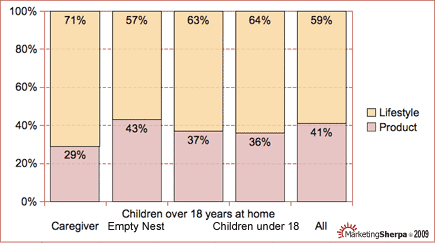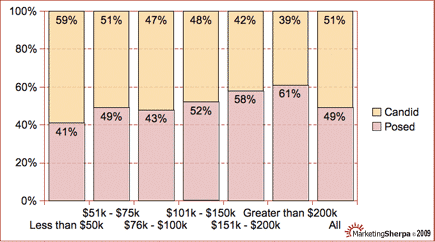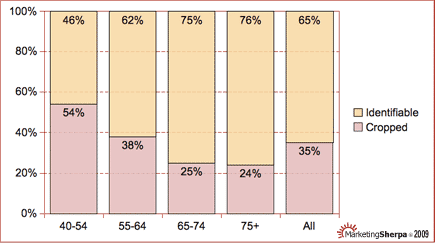Regardless of what demographic you’re marketing to, the preferences of segments within it can vary wildly by: different age groups within a larger age group; varying household incomes within a greater household income bracket, etc.
That’s what Erin Read Ruddick, Client Services Director, Creating Results, found while conducting a survey of 414 mature consumers (those older than 40 years-old) from September to December 2008. While filling out the survey, each respondent saw 12 ads.
Though there were some overarching similarities in mature consumers’ preferences, (most preferred single-image ads to multiple-image ones, and lifestyle ads to product ads), the differences in preference between segments, especially by age and gender, were very interesting.
Ruddick’s team found that 74% of female mature consumers preferred vibrant ads, for example, while 56% of male mature consumers preferred subdued ads.
Find out what else Ruddick’s team discovered and how they used those discoveries to tailor ads to the demographic.
5 Tips For Motivating Mature Consumers (plus insight into segment preferences)->Tip #1. Use single image ads, not collage-style adsSingle Image Ads vs. Collage by Age Group
Single-image ads were more effective at motivating mature consumers than collage-style ads. 66% of survey respondents said they preferred seeing a single image as opposed to a collage of images.
Survey respondents with the highest level of education – master’s recipients (74%) and doctorate recipients (79%) – found single-image ads more appealing.
All age groups preferred single-image ads, especially the 55- to 64-year-old group (71%).
Takeaway: If the goal is to motivate mature, well-educated consumers then single-image ads are the way to go.
Case Study example: When Kaine Homes, a small home builder, revamped an advertisement in a local real-estate magazine to show one dominant image instead of several smaller ones, the company was surprised by the response, says Ruddick. The single-image ad increased traffic, consisting mostly of mature consumers, to its new model home so much that the company had to employ extra staff on weekends for a while.
->Tip #2. Vibrant ads outperform subdued adsVibrant Ads vs. Subdued by Family Ties
Advertisements with bright colors and expressive models were more appealing to mature consumers than subdued advertisements featuring muted colors and static models. 65% of survey respondents chose vibrant ads to subdued ads.
Respondents with adult-age children at home (78%) responded especially well to the vibrant ads.
What’s interesting is that 74% of women preferred the vibrant ad, whereas 56% of men preferred the subdued ad.
In addition:
o 53% of age group 75 plus preferred the subdued ad
o 52% of survey respondents with household incomes of more than $200,000 per year preferred the subdued ad
Takeaway: It’s very important to pay attention to the preferences of segments within a demographic. Although most mature consumers prefer vibrant ads, if the target is men, 75-years-old or older who have annual household incomes of more than $200,000, it’s better to use a subdued ad.
Case Study example: When Westminster at Lake Ridge, a continuing-care retirement community, ran a vibrant ad featuring an older gentleman posing upside down in a handstand, they weren’t sure what to expect, says Ruddick. But the ad was very successful. It contributed to boosting the community’s occupancy rate to 96% within weeks of running.
->Tip #3. Lifestyle images preferred to product imagesLifestyle Images vs. Product by Family Ties
The preference for lifestyle images was consistent across all age groups, income, education levels, and family situations. 59% of survey respondents preferred lifestyle images to product images.
Other stats:
o 71% of caregivers preferred lifestyle images
o 64% of associate or bachelor’s degree holders preferred lifestyle images
o 61% of survey respondents with $200,ooo plus household incomes per year preferred lifestyle images
Takeaways: The higher the education level, the lower the preference for lifestyle images. Those with doctorates or PhDs (54%) preferred product images to lifestyle images.
Similarly, there was a significant discrepancy between how much caregivers (71%) preferred lifestyle images to how much empty nesters (57%) preferred lifestyle images.
People who chose travel as their favorite activity preferred product images. “They wanted to put themselves in the picture,” Ruddick says.
Case Study example: A lifestyle ad depicting a group of mature models hanging out at the real-estate community, Central Parke at Lowes Island, drove about 99 mature consumers to attend a pre-sale breakfast about the community, which had not opened. One-third of them provided a deposit for sight-unseen real-estate property at the community, Ruddick says. There were no other marketing efforts besides the ad at the time.
->Tip #4. Posed shots attract the wealthy/older generationsCandid Shots vs. Posed by Annual Household Income
Only 51% of mature consumers preferred candid shots to posed shots. That’s a very small margin between those who preferred candid shots and those who preferred posed shots.
Takeaway: The decision to shoot a posed versus a candid shot should really depend on whom an ad is targeting, Ruddick says.
o Older consumers (75 plus) preferred posed shots (55%)
o Younger consumers (40- to 54) preferred candid shots (57%)
o More wealthy consumers who had annual household incomes of $101,000 or more preferred posed shots (52% to 58%)
o Less wealthy consumers who had less than $101,000 annual household incomes preferred candid shots (47% to 59%)
In conclusion, the higher the income and the older the person, the more they preferred posed shots. The lower the income and the younger the person, the more they preferred candid shots.
Most of the men surveyed preferred the candid image, which went against the hypothesis concluding that men normally prefer order and structure, Ruddick says.
And many women did not like the candid image because it depicted a woman working in a kitchen while a man stood by with a drink in his hand.
“We caution marketers: Don’t think only about the structure of your image,” she says. “Think about what underlying messages it’s sending.”
->Tip #5. Older consumers prefer identifiable imagesIdentifiable Images vs. Cropped by Age Group
Overall, 65% of mature consumers preferred to see identifiable people in photos as opposed to cropped images that didn’t show a person’s face.
Takeaway: The older the consumers, the more they prefer to see the face of the subject in the photo.
o 54% of 40- to 54-year-olds preferred cropped photos
o 76% of 75-year-olds plus preferred identifiable photos
All of the survey results show that it is important to know whom an advertisement is targeting before designing an ad, says Ruddick.
The more that is known about the age, gender, income level, education level, hobbies and interests of the target audience, the better the chance of creating an ad that resonates with those consumers.
“We can note from the survey data some of the different preferences by age,” Ruddick says, adding that this is especially true for the identifiable image category.
Useful links related to this articleCreative samples from Creating Results:
http://www.marketingsherpa.com/cs/matureconsumers/study.html
Kaine Homes:
http://www.kainehomes.com/
Westminster at Lake Ridge:
http://www.wlrva.org/
Central Parke at Lowes Island:
http://www.centralparke.com/li/
Creating Results:
http://www.creatingresults.com/index.html














